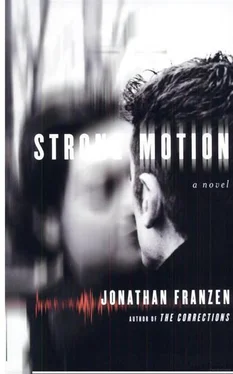What was certain was that the Eastern United States had suffered its largest earthquake since Charleston, South Carolina, was crunched in 1886. The contamination of Peabody and the scandal of corporate culpability naturally received the most press in the early going — every big American disaster seems to produce one particularly grim spectacle — but as the situation there stabilized, attention shifted to the serious wounds that the rest of north suburban Boston and the city itself had suffered. Rescue workers digging in the rubble of a children’s home in Salem had exhumed eight small bodies. Heart attacks had killed at least ten Hub men and women; Channel 7 interviewed neighbors of a West Somerville man named John Mullins who had staggered from his house and fallen dead in the street with his arms outstretched “like he’d been shot.” Perchloroethylene pouring out of dry-cleaning establishments had put six people in the hospital. Librarians in every town from Gloucester to Cambridge were wading into hip-deep swamps of unshelved books. Shawmut Bank’s mainframe had crashed and an electrical fire had wiped out hundreds of magnetic tapes containing account information; the bank closed its doors for a week, and its customers, finding that their ATM cards wouldn’t work at other banks either, had to barter and beg and borrow just to get food and bottled water. Many people complained of lingering seasickness. After Sunday night, only three minor aftershocks were felt, but each of them caused hundreds of people to stop whatever they were doing and sob uncontrollably. Everything was a mess — houses, factories, highways, courts. On Friday morning federal relief coordinators estimated that the total cost of the earthquake, including property damage and the interruption of economic activity, but not including the contamination in Zones I and II, would come to between four and five billion dollars. Editorialists called this figure staggering; it was roughly what it had cost Americans to service the national debt over the Memorial Day weekend.
Probably the most notorious casualty of the earthquake was Philip Stites’s Church of Action in Christ. In much the same way as they composed obituaries for the living, local news organizations had prepared for the church’s destruction with pre-written triumphant editorials and pre-allocated news teams. As soon as the seismic waves had rolled over Chelsea, four independent minicam vans raced through the blacked-out, fissured streets and reached the church within a minute of each other. Devastation appeared to be satisfactory, though not extreme. Strong motion had split the tenement down the middle, entirely flattening the ground floor on one side of the clerestory, reducing the clerestory itself to a tangle of reinforcing rods caging chunks of concrete, and turning doors and windows into nasty rhomboids. Smoke was surging furiously, impatiently, from the rear of the building, and Philip Stites looked as if a blood-yoked egg had been cracked open on his head. He ran up the street shouting, “Help us . Put the cameras down . Help us ,” because the news crews were in fact the only people there to help, and it would be another twenty minutes before anyone else arrived.
Later in the week, Stites claimed that a true miracle had occurred on that dark, humid night: all of the newspeople, every one of them, had put their cameras and recorders down and followed him into the stricken building. They had kicked open jammed doors, releasing herds of screaming, bloodied women. They had braved falling plaster and clouds of black smoke to drag church members with broken limbs from the path of the fire. They had caught men and women jumping out of windows and had cleared equipment from their vans in order to rush them to the hospital. They had saved, Stites said, at least twenty lives. But it reflected a new and uncharacteristic bitterness on the minister’s part that he chose to call the newspeople’s heroism a miracle. He did not, for example, see a miracle in the fact that no one in his church had perished. He did not say that God had protected His faithful from His earthquake. He took no pleasure whatsoever in God’s mercy, because when the smoke had cleared and the sun had risen, he found that he no longer had a church.
He set up a tent in the tenement courtyard and promised to get other tents for the three hundred members of his congregation, but all but a handful declined his offer. Most of them simply left Boston, went home to Missouri, Kansas, Georgia. The rest quietly defected to a rival anti-abortion group called We Love Life whose trademark “action” was to harass clinics with recordings of newborn babies wailing at a hundred decibels. One of these defectors looked a Channel 4 news camera dead in the eye and said, “I don’t believe anymore that Mr. Stites is guided by divine Providence, not after that night of terror. I thank the Lord I escaped with life and limb. Not everybody did, you know, I have a dear friend in the hospital paralyzed with a broken back. I believe Mr. Stites is a great teacher and moral leader led astray by too much pride and we should never of been in that building.”
Another defector, Mrs. Jack Wittleder, was more succinct: “The Reverend Stites let a sinful woman tempt him. We have all now paid the price.” The Channel 4 reporter said: Woman? What woman?? But Mrs. Wittleder declined to elaborate.
Stites himself spoke to Channel 4. “What I really believe in my heart? I believe that God brought down our building for a purpose. I believe the destruction was a test of faith and we flat-out failed it. I thought — I fervently hoped — we had a church that was stronger than any building, and a faith that no earthquake would ever shake. And I still have that faith in my own heart, but I don’t have a church, and I am deeply humbled and disappointed.”
Stites soon also achieved the distinction of being the first defendant named in a lawsuit arising from the earthquake. The family of the church member whose back was broken accused him of fraud and willful negligence in persuading her to stay in an unsafe building; they sought ten million dollars in real and punitive damages. Stites’s lawyer told the press that his client’s entire worldly possessions consisted of one army-surplus tent, one sleeping bag, a Bible, one suitcase of clothes, a car, and one financially troubled radio station. This didn’t stop four other injured church members from filing suit on July 11.
It became a season of lawsuits. Lawsuits salved the raw nerves of the million survivors and held out hope to the bereft. They eased the transition back to normalcy when the networks and newspapers released their hostages; they provided the grist for follow-up reports. They bottled the terrible dread and emptiness back into people’s unconscious, where they belonged. By the end of July the Commonwealth of Massachusetts had been named in eleven different suits accusing it of such creative torts as failure to establish adequate plans for evacuation in the event of toxic chemical dispersal, lethargy in providing shelter for families from Zones I and II, and calculated deception in its assessments of local seismic risk. The Commonwealth in turn was suing the federal government and the builders of various failed highways and public buildings. It was also, like nearly everyone else in Boston, suing Sweeting-Aldren. As of August 1 total claims against the company exceeded ten billion dollars and were rising daily. To pay these claims, the company had few uncontaminated current assets, a long-term debt of fifty million dollars, and little prospect of ever selling anything again. It was taken for granted that the federal government would ultimately foot the cleanup bill.
Renée Seitchek was released from Brigham & Women’s Hospital on July 27. A ten-second clip on the evening news showed her being wheeled from the hospital towards a dented Honda Civic, but by this point the press had soured on her story, because she refused to be interviewed. The investigation of her shooting was stalled (“probably a lost cause,” detectives conceded privately), but authorities were still hoping to bring Sweeting-Aldren’s management home to face a variety of other criminal charges. The FBI had tracked the five men — Aldren, Tabscott, Stoorhuys, the corporation counsel, and the chief financial officer — to a tiny island south of St. Kitts, where the corporation had long maintained three beach houses for business entertaining and executive vacations. Aldren’s twenty-three-year-old wife, Kim, and Tabscott’s twenty-six-year-old girlfriend, Sondra, had joined the party a few days after the earthquake, the corporation counsel’s family had visited on the Fourth of July, and seafaring paparazzi had managed to photograph a beach picnic that resembled a beer commercial in all the particulars. (The Globe ran one of these pictures on its front page alongside a shot of Mylar-suited men shoveling birds and mammals into an incinerator.) Unfortunately the government of St. Kitts-Nevis showed no intention of delivering the executives up to justice, and the Administration in Washington, perhaps mindful of Aldren and Tabscott’s longtime financial support for the Republican Party, said there was little the United States could do about it.
Читать дальше
Конец ознакомительного отрывка
Купить книгу












